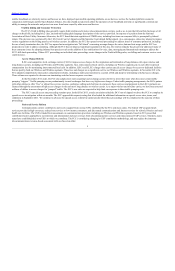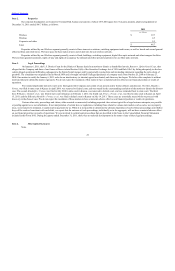Sprint - Nextel 2011 Annual Report Download - page 21
Download and view the complete annual report
Please find page 21 of the 2011 Sprint - Nextel annual report below. You can navigate through the pages in the report by either clicking on the pages listed below, or by using the keyword search tool below to find specific information within the annual report.
Table of Contents
Consolidation and competition in the wholesale market for wireline services, as well as consolidation of our roaming partners and access providers used for wireless
s
ervices, could adversel
y
a
ff
ect our revenues and pro
f
itabilit
y
.
Our Wireline segment competes with AT&T, Verizon Communications, CenturyLink, Level 3 Communications Inc., other major local incumbent operating
companies, and cable operators, as well as a host of smaller competitors. Some of these companies have high-capacity, IP-based fiber-optic networks capable of
supporting large amounts of voice and data traffic. Some of these companies claim certain cost structure advantages that, among other factors, may allow them to offer
services at lower prices than we can. In addition, consolidation by these companies could lead to fewer companies controlling access to more cell sites, enabling them to
control usage and rates, which could negatively affect our revenues and profitability.
We provide wholesale services under long-term contracts to cable television operators which enable these operators to provide consumer and business digital
telephone services. These contracts may not be renewed as they expire. Increased competition and the significant increase in capacity resulting from new technologies and
networks may drive already low prices down further. AT&T and Verizon Communications continue to be our two largest competitors in the domestic long distance
communications market. We and other long distance carriers depend heavily on local access facilities obtained from ILECs to serve our long distance subscribers, and
payments to ILECs for these facilities are a significant cost of service for our Wireline segment. The long distance operations of AT&T and Verizon Communications
have cost and operational advantages with respect to these access facilities because those carriers serve significant geographic areas, including many large urban areas, as
the ILEC.
In addition, our Wireless segment could be adversely affected by changes in rates and access fees that result from consolidation of our roaming partners and
access providers, which could negatively affect our revenues and profitability.
The blurring of the traditional dividing lines among long distance, local, wireless, video and Internet services contributes to increased competition.
The traditional dividing lines among long distance, local, wireless, video and Internet services are increasingly becoming blurred. Through mergers, joint
ventures and various service expansion strategies, major providers are striving to provide integrated services in many of the markets we serve. This trend is also reflected
in changes in the regulatory environment that have encouraged competition and the offering of integrated services.
We expect competition to intensify as a result of the entrance of new competitors or the expansion of services offered by existing competitors, and the rapid
development of new technologies, products and services. We cannot predict which of many possible future technologies, products, or services will be important to
maintain our competitive position or what expenditures we will be required to make in order to develop and provide these technologies, products or services. To the extent
we do not keep pace with technological advances or fail to timely respond to changes in the competitive environment affecting our industry, we could lose market share or
experience a decline in revenue, cash flows and net income. As a result of the financial strength and benefits of scale enjoyed by some of our competitors, they may be
able to offer services at lower prices than we can, thereby adversely affecting our revenues, growth and profitability.
If
we are unable to improve our results o
f
operations, we
f
ace the possibilit
y
o
f
additional char
g
es
f
or impairments o
f
lon
g
-lived assets. Further, our future operating
results will be impacted by our share of Clearwire's net loss, which will likely negatively affect our results of operations. The carrying value of our investment in
Clearwire may be subject to further impairment.
We review our long-lived assets for impairment whenever changes in circumstances indicate that the carrying amount may not be recoverable. If we continue
to have operational challenges, including obtaining and retaining subscribers, our future cash flows may not be sufficient to recover the carrying value of our long-lived
assets, and we could record asset impairments that are material to our consolidated results of operations and financial condition. If we continue to have challenges
retaining subscribers and as we assess the deployment of Network Vision, management may conclude, in future periods, that certain equipment assets will never be either
deployed or redeployed, in which case additional cash and/or non-cash charges that could be material to our consolidated financial statements would be recognized.
We account for our investment in Clearwire using the equity method of accounting and, as a result, we record our share of Clearwire's net income or net loss,
which could adversely affect our consolidated results of
19
























